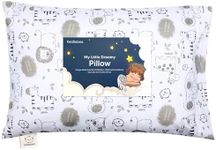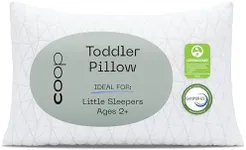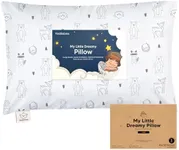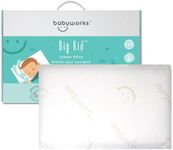Buying Guide for the Best Toddler Pillows
Choosing the right pillow for your toddler is an important step in ensuring their comfort and safety during sleep. Toddlers have different needs than adults or older children, so it's essential to focus on features that support their small size, developing bodies, and sensitive skin. When shopping for a toddler pillow, pay attention to the materials, size, firmness, and safety certifications. Understanding these key aspects will help you make a choice that promotes healthy sleep and peace of mind.Pillow SizePillow size refers to the dimensions of the pillow, and it's important because toddlers need a pillow that fits their smaller heads and beds. Standard toddler pillows are usually smaller than adult pillows, typically around 12 by 16 inches. A pillow that's too large can be uncomfortable and may pose a safety risk, while one that's too small might not provide enough support. When choosing, look for pillows specifically labeled for toddlers, as these are designed to fit their proportions and sleeping needs.
FirmnessFirmness describes how soft or hard the pillow feels. For toddlers, a pillow that is too soft can increase the risk of suffocation, while one that is too firm may be uncomfortable. The ideal toddler pillow is gently supportive—soft enough to be comfortable but firm enough to hold its shape and provide support. When picking firmness, consider your child's sleeping habits and preferences, but always prioritize safety by avoiding overly plush or thick pillows.
Filling MaterialFilling material is what the pillow is stuffed with, and it affects comfort, support, and potential allergies. Common fillings include polyester fiber, memory foam, and natural materials like cotton or wool. Polyester is lightweight and hypoallergenic, making it a popular choice. Natural fillings can be more breathable but may trigger allergies in sensitive children. When choosing, think about your child's sensitivities and whether you prefer synthetic or natural materials for breathability and ease of cleaning.
Cover MaterialThe cover material is the fabric that encases the pillow, and it's important for comfort and skin health. Cotton is a common choice because it's soft, breathable, and gentle on sensitive skin. Some covers are also made with organic or hypoallergenic materials, which can be beneficial for children with allergies or eczema. When selecting a cover, look for materials that are soft, easy to wash, and free from harsh chemicals or dyes.
WashabilityWashability refers to how easy it is to clean the pillow. Toddlers can be messy, so a pillow that can be machine washed and dried is very practical. Some pillows have removable, washable covers, while others can be washed entirely. When choosing, consider how often you might need to clean the pillow and whether the materials will hold up to frequent washing without losing shape or comfort.
Safety CertificationsSafety certifications indicate that the pillow has been tested for harmful substances and meets certain safety standards. Certifications like OEKO-TEX or CertiPUR-US can give you peace of mind that the pillow is free from toxic chemicals and safe for your child. When shopping, look for these labels, especially if your child has allergies or sensitive skin, or if you want to ensure the highest safety standards.
Age AppropriatenessAge appropriateness means the pillow is designed for the developmental stage of your child. Not all pillows are suitable for all ages, and introducing a pillow too early can be unsafe. Most experts recommend waiting until your child is at least 18 months old before introducing a pillow. When choosing, check the manufacturer's recommended age range to ensure the pillow is suitable for your toddler's age and size.



















